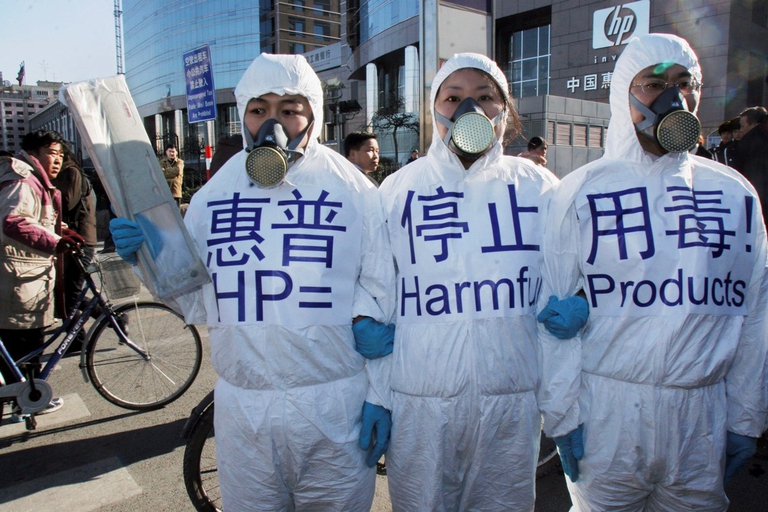
Three people putting the protection of the planet before themselves. Three powerful stories from Latin America, the deadliest region for environmental activists.
Driven by an endless thirst for new technology, Americans keep buying new gadgets, leaving behind older models. The result is the accumulation of huge amounts of toxic electronic waste. Some companies show ethics and responsibility by recycling within US borders despite high costs and low profitability. However, most manufacturers, more interested in their profits than
Driven by an endless thirst for new technology, Americans keep buying new gadgets, leaving behind older models. The result is the accumulation of huge amounts of toxic electronic waste. Some companies show ethics and responsibility by recycling within US borders despite high costs and low profitability. However, most manufacturers, more interested in their profits than the environment, decide to export such waste to developing countries as a money-saving measure.
As the resale value of materials extracted by recycling has greatly declined in recent years, tech companies choose to ship their electronic waste to developing countries to avoid the higher cost of recycling at home. Responsible recycling companies are facing increasing costs to dispose of used tech devices safely and are losing business to companies that choose to ship electronic scraps overseas or just leave them in warehouses instead of processing them, as Hugo Neu Recycling and Sage Sustainable Electronics CEO’s Robert Houghton explains.
The toxic lead, mercury and cadmium contained in many gadgets can poison the workers handling them, seep into the soil and groundwater, and contaminate the air when burned. Basel Action Network, named after the 1989 United Nations Basel Convention, was created in 1997 by Jim Puckett with the goal of restricting and ending the toxic trade of hazardous waste. Its most recent investigation involved tracking the final destination of old hazardous electronic equipment via GPS. As a result, the computer giant Dell Inc. and non-profit Goodwill were exposed for exporting E-waste to several Asian countries. Low prices on electronics make survival difficult for the recyclers. In Puckett’s words, “electronic waste on the whole isn’t worth anything”.
Our #trackingewaste report leads @CityofSeattle @EcologyWA et al. to look harder at #ewaste: https://t.co/WZtoSRyrJEhttps://t.co/aF6hUFSW6F
— KCTS 9 (@KCTS9) May 20, 2016
While laws on electronic waste disposal and export exist in several US states, only the federal government has the power to restrict exports. Curiously, the US isn’t forbidden from shipping electronic waste abroad, because it’s the only developed nation that has signed, but not yet ratified, the Basel Convention on hazardous waste. American E-waste often ends up in China, India and Ghana, even though these nations are among the many countries not allowed to import such trash. Buyers purchase E-waste at arrival docks, risking toxic exposure in the hope of making some extra money through recycling. Sadly, only 25 per cent of the discarded electronics that are exported are repaired and reused.
According to the Environmental Protection Agency, the US generated 3.14 million tonnes of electronic waste in 2013, while the nation’s average household owns 28 consumer electronics. The United Nations reported that in 2014 only 16 per cent of the world’s E-waste was recycled. The Resource Conservation and Recovery Act promotes the safe management, export and disposal of hazardous waste; however, the EPA classifies most electronic waste as non-hazardous, with the exception of lead-lined glass cathode ray tubes, used in older models of televisions and computer monitors.
As stated by Jim Puckett, Apple is one of the more responsible recyclers in the tech industry. The company’s annual Environmental Responsibility Report shows that in 2015 the company recycled discarded products equal to 71 per cent of the total weight of the merchandise it sold during the past seven years, while also diverting more than 40 million kilogrammes of E-waste from landfills. Apple works with over 160 recyclers around the world, all respecting rigorous standards of environmental compliance, health and safety, and social responsibility.
Most consumer technology companies are constantly releasing new devices, instead of making smartphones and other gadgets more durable, less toxic and easier to repair. Because of the relatively low-cost of electronics, buyers want new rather than refurbished products, therefore worsening the E-waste problem. Consumers can choose to buy only products that are made sustainably. They can also dispose of old gadgets by bringing them to recycling facilities certified under the e-Stewards program, fully compliant with the Basel Convention.
Siamo anche su WhatsApp. Segui il canale ufficiale LifeGate per restare aggiornata, aggiornato sulle ultime notizie e sulle nostre attività.
![]()
Quest'opera è distribuita con Licenza Creative Commons Attribuzione - Non commerciale - Non opere derivate 4.0 Internazionale.
Three people putting the protection of the planet before themselves. Three powerful stories from Latin America, the deadliest region for environmental activists.
Influential scientist, activist and author Vandana Shiva fights to protect biological and cultural diversity, and against GMOs.
Kimiko Hirata has blocked 13 new coal plants in Japan, but she hasn’t done it alone. The 2021 Goldman Prize winner tells us about her movement.
The Goldman Environmental Prize, the “green Nobel Prize”, is awarded annually to extraordinary activists fighting for the well-being of the planet.
We talk to Shaama Sandooyea, activist and marine biologist from Mauritius onboard Greenpeace’s Arctic Sunrise ship in the heart of the Indian Ocean.
Arrested for supporting farmers. The alarming detention of Disha Ravi, a 22-year-old Indian activist at the fore of the Fridays for Future movement.
Water defender Eugene Simonov’s mission is to protect rivers and their biodiversity along the borders of Russia, China and Mongolia.
Chibeze Ezekiel, winner of the 2020 Goldman Environmental Prize for Africa, is fighting to guide new generations towards a renewable future.
Leydy Pech, winner of the 2020 Goldman Environmental Prize for North America, is the beekeeper who defended Mexican Maya land against the agro-industry.








